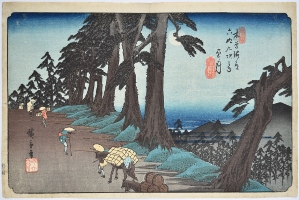Utagawa HIROSHIGE (1797-1858)
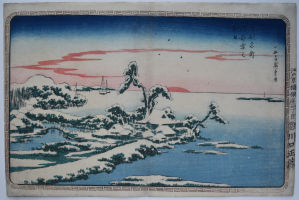
Click here to view image full size.
Susaki yuki no hatsuhi, “Snow on New Year’s Day at Susaki” from a Toto meisho “Famous Places in the Eastern Capital” set of ten prints published c. 1831-2 by Kawaguchiya Shozo. Hiroshige’s first oban landscape set with some outstanding designs. Fukagawa Susaki was a spit of land along Edo Bay. (Also the subject of the Eagle design, Jumantsubo Fukagawa Susaki, from the One Hundred Views of Edo later on.) The first editions, as here, have decorative borders adding a western element into the designs. These were removed on later editions. Extremely rare in this state.
Fine impression and colour. Very minor edge soil and slight centre fold, otherwise very good condition. Prints from this set are often missing or have the publisher’s name and address on the right border trimmed. Signed Ichiyusai Hiroshige ga. (The last set to be signed like this.)
Status: Sold
Utagawa HIROSHIGE (1797-1858)
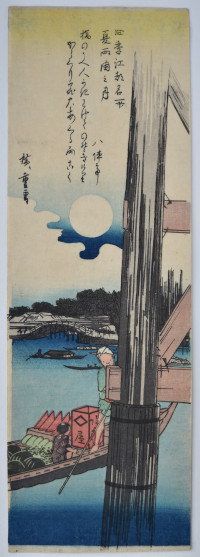
Click here to view image full size.
A chu-tanzaku print, Natsu, Ryogoku no tsuki, “Summer Moon at Ryogoku Bridge” from a set Shiki Koto meisho, “Famous Views of Edo in the Four Seasons.” Published by Kawaguchiya Shozo, 1834-5.
Fine impression, colour and condition. Signed Hiroshige ga.
Status: Sold
Utagawa HIROSHIGE (1797-1858)
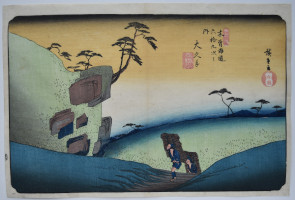
Click here to view image full size.
Okute from Kisokaido rokujukyutsugi no uchi, “The Sixty-nine Stations of the Kisokaido.” The set of seventy prints was started by Eisen and published by Hoeido in 1835, but in 1837 Hiroshige took over and completed the series with the publisher Iseya Rihei (Kinjudo). Shows woodcutters making their way home as evening approaches.
Fine impression: There is a plug of wood next to the last rock on the right. This repair gradually reveals itself and moves out leaving a gap. On the earliest impressions, as here, nothing is discernible. Slight fading of red, otherwise fine colour. Slight centre fold, otherwise fine condition. Signed Hiroshige ga.
Status: Sold
Utagawa HIROSHIGE (1797-1858)
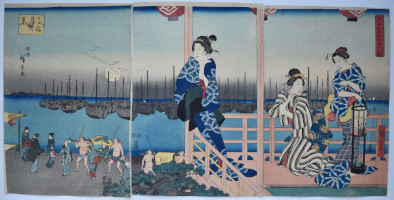
Click here to view image full size.
A triptych, Takanawa tsuki no kei, “Moon at Takanawa” from a set Edo meisho shiki no nagame, “Famous Places of Edo in the Four Seasons.” Shows beauties on the veranda of an inn overlooking the bay. Takanawa was a popular place to visit with views on a clear day of the Boso mountains across Edo Bay. Hiroshige depicted this area many times. Published by Maruya Jimpachi (Enjudo), 1847-8.
Very fine impression. Fine colour. Minor trimming, otherwise very good condition. Signed Hiroshige ga.
Status: Sold
Utagawa HIROSHIGE (1797-1858)
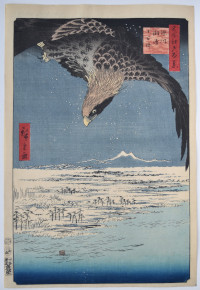
Click here to view image full size.
Fukagawa, Suzaki, Juman-tsubo, “The One Hundred Thousand Tsubo Plain, Suzaki, Fukagawa” from Meisho Edo hyakkei, “One Hundred Famous Views of Edo.” The set published by Uoya Eikichi between 1856 and 1859 (this being 1857). An eagle hovers over the snowy coastal plain, Mt Tsukuba and the Chiba mountains in the distance. Collectors at the beginning of the 20th century considered this the pre-eminent design from the set. Since then Ohashi has replaced it.
Fine impression, colour and condition. A nice early impression. Signed Hiroshige ga.
Status: Sold
Utagawa HIROSHIGE (1797-1858)
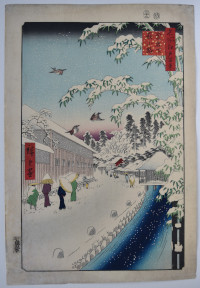
Click here to view image full size.
Atago shita Yabukoji, “Bamboo Lane Below Atago Hill” from Meisho Edo hyakkei, “One Hundred Famous Views of Edo.” The set published by Uoya Eikichi between 1856 and 1859 (this being 1857). A snow scene showing figures beside a stream, Atago Hill was to the right and lay just outside the northeast corner of the mansion of the daimyo of Minakuchi. It was the highest natural point in Edo.
Superb impression of the extremely rare first edition. Very fine colour. Left corner margin expertly restored, otherwise fine condition. Large margins. Signed Hiroshige ga.
Status: Sold
Utagawa HIROSHIGE (1797-1858)
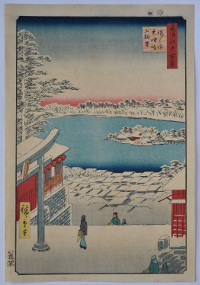
Click here to view image full size.
A snow scene: Yushima Tenjin sakaue chobo, “Hilltop View, Yushima Tenjin Shrine.” The shrine is dedicated to scholars and is near Ueno Park. From the set Meisho Edo hyakkei, “One Hundred Views of Edo.” The set published by Uoya Eikichi 1856-58 (this being 1856). The set comprises 118 prints by Hiroshige and another by Hiroshige II. However, three prints are dated 10/1858, the month following Hiroshige’s death, and these are thought to be by Hiroshige II as well. They are: Ueno Yamashita, Ichigaya Hachiman and Bikunibashi.
Fine impression, colour and condition. Signed Hiroshige hitsu.
Status: Sold
Utagawa HIROSHIGE (1797-1858)
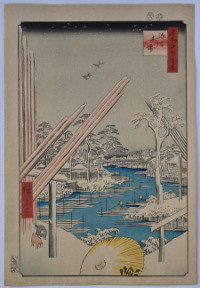
Click here to view image full size.
A snow scene: Fukagawa kiba, “Fukagawa Timber Yards.” The yards date back and are the result of the Meireki fire of 1657. Large amounts of wood was required for expanding Edo and the wood yards were moved to this area of swampland east of the Sumida River. From the set Meisho Edo hyakkei, “One Hundred Views of Edo.” The set published by Uoya Eikichi 1856-58 (this being 1856). The set comprises 118 prints by Hiroshige and another by Hiroshige II. However, three prints are dated 10/1858, the month following Hiroshige’s death, and these are thought to be by Hiroshige II as well. They are: Ueno Yamashita, Ichigaya Hachiman and Bikunibashi.
Fine impression, colour and condition. Signed Hiroshige hitsu.
Status: Sold
Utagawa HIROSHIGE (1797-1858)
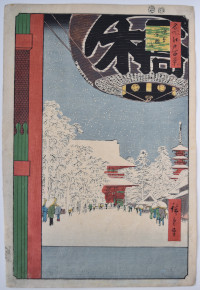
Click here to view image full size.
Asakusa Kinryuzan, “The Kinryuzan Temple at Asakusa” from Meisho Edo hyakkei, “One Hundred Famous Views of Edo.” The set published by Uoya Eikichi between 1856 and 1859 (this being 1856). A snow scene showing the oldest Buddhist temple in the city, the Sensoji or Asakusa Kannon, built on the low hill of Kinryuzan. Shows the Kaminarimon gate with the huge lantern with one character of the name shinbashi (a donor’s organisation).
Very good early impression and colour. Before the square plug becomes evident on the bottom left. Very good condition. Signed Hiroshige ga.
Status: Sold
Utagawa HIROSHIGE (1797-1858)
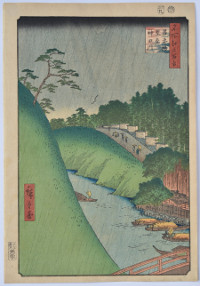
Click here to view image full size.
Shoheibashi Seido Kandagawa, “Seido Shrine and Kanda River Seen from Shohei Bridge.” The scene under light rain and is near present day Akihabara. From the set Meisho Edo hyakkei, “One Hundred Views of Edo.” The set published by Uoya Eikichi 1856-58 (this being 1857). The set comprises 118 prints by Hiroshige and another by Hiroshige II. However, three prints are dated 10/1858, the month following Hiroshige’s death, and these are thought to be by Hiroshige II as well. They are: Ueno Yamashita, Ichigaya Hachiman and Bikunibashi.
Superb impression of the first edition. Fine colour and condition. Signed Hiroshige ga.
Status: Sold
Utagawa HIROSHIGE (1797-1858)
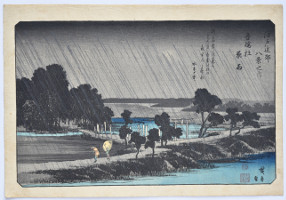
Click here to view image full size.
Azuma no mori yoru no ame, “Evening Rain at Azuma Shrine.” From a fine and rare early set Edo kinko hakkei, ”Eight Views in the Environs of Edo.” Shows figures walking along a dike beside the Kita Jumagawa. Azuma Shrine is seen amongst trees to the left. This set was first published privately for the Taihaido Poetry Club by the publisher Sanoya Kihei (Kikakudo) c 1837-8. (Similar to Hiroshige’s first set of fish prints.) For obvious reasons examples of these prints are of the utmost rarity. An entire set is in the Baur Collection, Matthi Forrer, 1994, nos. G492 – G499, this being G498. They have the copyright owner’s name in the left border, Taihaido Nomimasu, who was the head of the poetry club. They also have three poems on each design. The commercial edition, as here, has one or two poems and loses the Taihaido name. (Again, similar to the fish series.) These prints, initially not intended for commercial consumption, are more refined with a greater degree of care taken with the cutting of the blocks. Contrary to later sets, figures are small, pigments are subdued and large foreground objects are not in evidence yet. One of Hiroshige’s finest sets. Rare.
Very fine impression. Fine colour and condition with large margins. Signed Hiroshige ga.
Status: Sold
Utagawa HIROSHIGE (1797-1858)
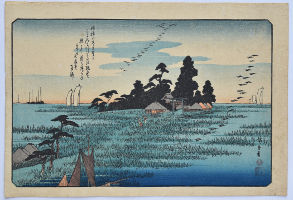
Click here to view image full size.
Haneda no rakugan, “Descending Geese at Haneda.” From a fine and rare early set Edo kinko hakkei, ”Eight Views in the Environs of Edo.” Planes now descend here. This set was first published privately for the Taihaido Poetry Club by the publisher Sanoya Kihei (Kikakudo) c 1837-8. (Similar to Hiroshige’s first set of fish prints.) For obvious reasons examples of these prints are of the utmost rarity. An entire set is in the Baur Collection, Matthi Forrer, 1994, nos. G492 – G499, this being G492. They have the copyright owner’s name in the left border, Taihaido Nomimasu, who was the head of the poetry club. They also have three poems on each design. The commercial edition, as here, has one or two poems and loses the Taihaido name. (Again, similar to the fish series.) These prints, initially not intended for commercial consumption, are more refined with a greater degree of care taken with the cutting of the blocks. Contrary to later sets, figures are small, pigments are subdued and large foreground objects are not in evidence yet. One of Hiroshige’s finest sets. Rare.
Very fine impression. Fine colour. Minimal edge soil, otherwise fine condition with large margins. Signed Hiroshige ga.
Status: Sold
Utagawa HIROSHIGE (1797-1858)
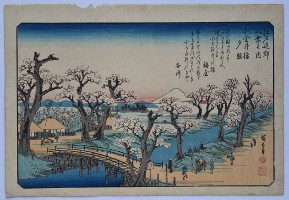
Click here to view image full size.
Koganeibashi no sekisho, “Evening Glow at Koganei Bridge.” From a fine and rare early set Edo kinko hakkei, ”Eight Views in the Environs of Edo.” This area was famous for its cherry trees and visitors are seen cherry viewing. It is also where the Tamagawa-josui was made to draw water from the Tama River into Edo. This set was first published privately for the Taihaido Poetry Club by the publisher Sanoya Kihei (Kikakudo) c 1837-8. (Similar to Hiroshige’s first set of fish prints.) For obvious reasons examples of these prints are of the utmost rarity. An entire set is in the Baur Collection, Matthi Forrer, 1994, nos. G492 – G499, this being G495. They have the copyright owner’s name in the left border, Taihaido Nomimasu, who was the head of the poetry club. They also have three poems on each design. The commercial edition, as here, has one or two poems and loses the Taihaido name. (Again, similar to the fish series.) These prints, initially not intended for commercial consumption, are more refined with a greater degree of care taken with the cutting of the blocks. Contrary to later sets, figures are small, pigments are subdued and large foreground objects are not in evidence yet. One of Hiroshige’s finest sets. Rare.
Very fine impression. Fine colour. Small edge nibble on top border and minimal edge soil, otherwise fine condition with large margins. Signed Hiroshige ga.
Status: Sold
Utagawa HIROSHIGE (1797-1858)
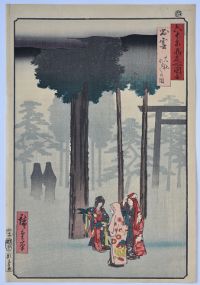
Click here to view image full size.
The great shrine at Izumo, Izumo, taisha hotohoto no zu from Rokujuyoshu meisho zue, “Famous Views in the Sixty-odd Provinces.” The set published by Koshimuraya Heisuke, 1853-6 (this being 1854). Shows a group of three young women bringing offerings to the Shinto shrine. A large cryptomeria tree in the foreground and other figures, trees and a torii in the misty background. The main deity of the shrine is Okuninushi no Okami, patron of good relationships and marriage (which probably accounts for the women’s visit). A beautiful design when well printed.
Fine early impression: Should have applied bokashi across the foreground area, as here. Fine colour. Slight vertical crease in left margin, otherwise fine condition. Signed Hiroshige hitsu.
Status: Sold
Utagawa HIROSHIGE (1797-1858)
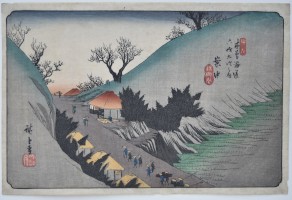
Click here to view image full size.
Station Annaka from Kisokaido rokujukyutsugi no uchi, “Sixty-nine Stations of the Kisokaido.” Published by Kinjudo, the set was started by Eisen in 1835 who designed twenty-four prints before Hiroshige replaced him and completed the series before 1843. Shows the entourage of a feudal lord progressing along the road between rest houses.
Very fine impression of the earliest printing. Fine colour and condition. Signed Hiroshige g
Status: Sold
Utagawa HIROSHIGE (1797-1858)
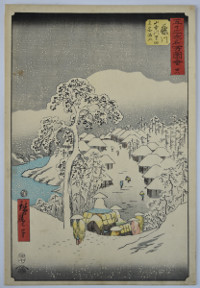
Click here to view image full size.
Fujikawa from the so-called “Upright Tokaido.” One of the two snow scenes from the set. Shows travellers coming and going at the edge of the village. Published by Tsutaya, Hare 7 (1855).
Very good impression and colour. Several small blemishes, otherwise very good condition. Signed Hiroshige ga.
Status: Sold
Utagawa HIROSHIGE (1797-1858)
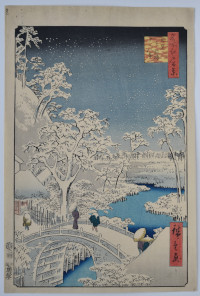
Click here to view image full size.
A snow scene: Meguro taikobashi yuhi no oka, “Drum Bridge and Sunset Hill, Meguro” from Edo meisho hyakkei, “The Hundred Famous Views of Edo.” Shows the valley of the Meguro River with travellers crossing the stone bridge, Yuhi Hill to the left. Stone bridges were uncommon in Edo because of the risk from earthquakes. Published by Uoya Eikichi between Ansei 3 and 5 (1856-58). This design dated Snake 4 (1857).
Very good impression, colour and condition. Signed Hiroshige ga.
Status: Sold
Utagawa HIROSHIGE (1797-1858)
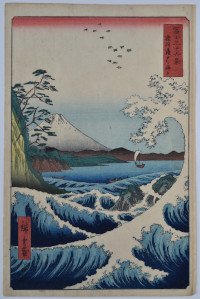
Click here to view image full size.
Suruga Satta no kaijo, “The Sea at Satta, Suruga Province” from Fuji sanjurokkei, “The Thirty-Six Views of Fuji.” The best design from the set published by Koeido (Tsutaya Kichizo), 4/1858. A huge wave breaks on the right releasing a flock of chidori. These birds were supposed to originate from the spume of these waves. Originally, travellers on the Tokaido had to traverse the base of the cliff, to the left. However, in 1655, a pass was cut in the cliff above. Fuji rises above the bay of Kiyomi. A popular design.
Very good impression and colour. Crease in right hand margin, otherwise very good condition. Signed Hiroshige ga.
Status: Sold
Utagawa HIROSHIGE (1797-1858)
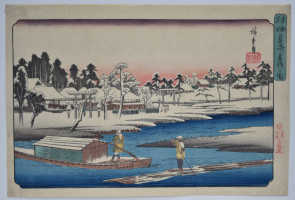
Click here to view image full size.
Masaki yukibare no zu, “Clear Weather After Snow at Masaki” from a Toto meisho, “Famous Sights of the Eastern Capital” set published by Kikakudo (Sanoki), the seal in red in right margin, c 1832-35. (Late editions have the seal in black.) There is confusion over how many prints belong to this series: The original set of twenty-one prints seems to have been extended to fifty-five in c 1839-42. The temple, under a deep layer of snow, is shown on the far shore. In the foreground two figures in yellow straw coats navigate the river.
Fine impression, colour and condition. Signed Hiroshige ga.
Status: Sold
Utagawa HIROSHIGE (1797-1858)
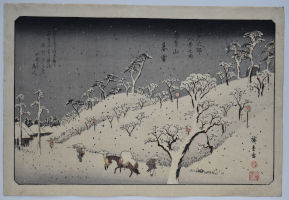
Click here to view image full size.
Asukayama bosetsu, “Evening Snow on Asuka Hill.” From a fine and rare early set Edo kinko hakkei, “Eight Views in the Environs of Edo.” Shows figures struggling through the deep snow. This set was first published privately for the Taihaido Poetry Club by the publisher Sanoya Kihei (Kikakudo) c 1837-8. (Similar to Hiroshige’s first set of fish prints.) For obvious reasons examples of these prints are of the utmost rarity. An entire set is in the Baur Collection, Matthi Forrer, 1994, nos. G492-G499. They have the copyright owner’s name in the left border, Taihaido Nomimasu, who was the head of the poetry club. They also have three poems on each design. The commercial edition, as here, has one or two poems and loses the Taihaido name. (Again, similar to the fish series.) These prints, initially not intended for commercial consumption, are more refined with a greater degree of care taken with the cutting of the blocks. Contrary to later sets, figures are small, pigments are subdued and large foreground objects are not in evidence yet. One of Hiroshige’s finest sets and this is one of his finest designs. Rare.
Very fine impression. Fine colour and condition with large margins and splashed gofun. Signed Hiroshige ga.
Status: Sold
Utagawa HIROSHIGE (1797-1858)
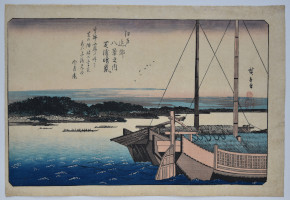
Click here to view image full size.
Shibaura no seiran, “Clearing Weather at Shiba Bay.” From a fine and rare early set Edo kinko hakkei, “Eight Views in the Environs of Edo.” Shows boats anchored on the edge of Edo Bay. This set was first published privately for the Taihaido Poetry Club by the publisher Sanoya Kihei (Kikakudo) c 1837-8. (Similar to Hiroshige’s first set of fish prints.) For obvious reasons examples of these prints are of the utmost rarity. An entire set is in the Baur Collection, Matthi Forrer, 1994, nos. G492-G499. They have the copyright owner’s name in the left border, Taihaido Nomimasu, who was the head of the poetry club. They also have three poems on each design. The commercial edition, as here, has one or two poems and loses the Taihaido name. (Again, similar to the fish series.) These prints, initially not intended for commercial consumption, are more refined with a greater degree of care taken with the cutting of the blocks. Contrary to later sets, figures are small, pigments are subdued and large foreground objects are not in evidence yet. One of Hiroshige’s finest sets. Rare.
Very fine impression. Fine colour and condition with large margins. Signed Hiroshige ga.
Status: Sold
Utagawa HIROSHIGE (1797-1858)
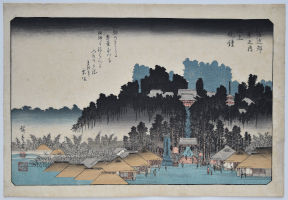
Click here to view image full size.
Ikegami no bansho, “Evening Bell at Ikegami.” From a fine and rare early set Edo kinko hakkei, “Eight Views in the Environs of Edo.”The otherwise nondescript town is famous for the large temple overlooking it. This was the Ikegami Honmonji, the main temple of the Lotus sect, a branch of Buddhism founded by Nichiren. This set was first published privately for the Taihaido Poetry Club by the publisher Sanoya Kihei (Kikakudo) c 1837-8. (Similar to Hiroshige’s first set of fish prints.) For obvious reasons examples of these prints are of the utmost rarity. An entire set is in the Baur Collection, Matthi Forrer, 1994, nos. G492-G499.They have the copyright owner’s name in the left border, Taihaido Nomimasu, who was the head of the poetry club. They also have three poems on each design. The commercial edition, as here, has one or two poems and loses the Taihaido name. (Again, similar to the fish series.) These prints, initially not intended for commercial consumption, are more refined with a greater degree of care taken with the cutting of the blocks. Contrary to later sets, figures are small, pigments are subdued and large foreground objects are not in evidence yet. One of Hiroshige’s finest sets. Rare.
Very fine impression. Fine colour and condition with large margins. Signed Hiroshige ga.
Status: Sold
Utagawa HIROSHIGE (1797-1858)
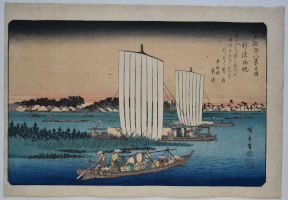
Click here to view image full size.
Gyotoku no kihan, “Returning Sails at Gyotoku.” From a fine and rare early set Edo kinko hakkei, “Eight Views in the Environs of Edo.” Gyotoku was a prosperous area on the Edogawa and Edo Bay. This set was first published privately for the Taihaido Poetry Club by the publisher Sanoya Kihei (Kikakudo) c 1837-8. (Similar to Hiroshige’s first set of fish prints.) For obvious reasons examples of these prints are of the utmost rarity. An entire set is in the Baur Collection, Matthi Forrer, 1994, nos. G492-G499. They have the copyright owner’s name in the left border, Taihaido Nomimasu, who was the head of the poetry club. They also have three poems on each design. The commercial edition, as here, has one or two poems and loses the Taihaido name. (Again, similar to the fish series.) These prints, initially not intended for commercial consumption, are more refined with a greater degree of care taken with the cutting of the blocks. Contrary to later sets, figures are small, pigments are subdued and large foreground objects are not in evidence yet. One of Hiroshige’s finest sets. Rare.
Very fine impression. Fine colour and condition with large margins. Signed Hiroshige ga.
Status: Sold
Utagawa HIROSHIGE (1797-1858)
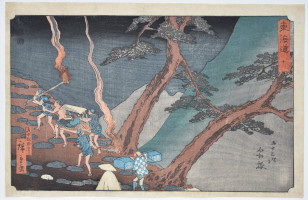
Click here to view image full size.
Hakone from the “Reisho” Tokaido. So-called because of the titles written in formal script. The best Tokaido set after the Hoeido. Shows travellers holding pine-torches climbing a mountain path at night. The Hakone mountains were one of the most gruelling parts of the Tokaido, but at the same time one of the most relaxing with the hot springs, Lake Ashi and the fine cryptomeria trees. Published by Marusei, c 1851-2. One of the five best designs from the set and probably the masterpiece. The composition and use of kimetsubishi to show the woodgrain in the night sky and mountains makes it one of Hiroshige’s most beautiful prints.
Very good impression, colour and condition. Signed Hiroshige ga.
Status: Sold
Utagawa HIROSHIGE (1797-1858)
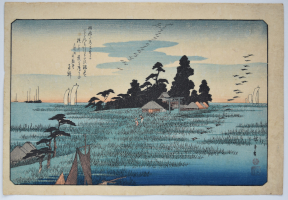
Click here to view image full size.
Haneda no rakugan, “Descending Geese at Haneda.” From a fine and rare early set Edo kinko hakkei, “Eight Views in the Environs of Edo.” Planes now descend here. This set was first published privately for the Taihaido Poetry Club by the publisher Sanoya Kihei (Kikakudo) c 1837-8. (Similar to Hiroshige’s fish prints.) For obvious reasons examples of these prints are of the utmost rarity. An entire set is in the Baur Collection, Matti Forrer, 1994, nos. G492 – G499, this being G492. They have the copyright owner’s name in the left border, Taihaido Nomimasu, who was the head of the poetry club. They also have three poems on each design. The commercial edition, as here, has one or two poems and loses the Taihaido name. (Again, similar to the fish series.) These prints, initially not intended for commercial consumption, are more refined with a greater degree of care taken with the cutting of the blocks. Contrary to later sets, figures are small, pigments are subdued and large foreground objects are not in evidence yet. One of Hiroshige’s finest sets. Rare.
Very fine impression. Fine colour. Minimal edge soil, otherwise fine condition with large margins. Signed Hiroshige ga.
Status: Sold
Utagawa HIROSHIGE (1797-1858)
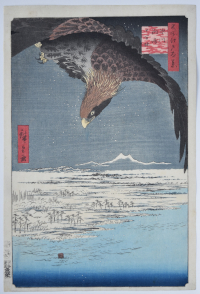
Click here to view image full size.
Fukagawa, Suzaki, juman-tsubo, “The One Hundred Thousand Tsubo Plain, Suzaki, Fukagawa” from Meisho Edo hyakkei, “One Hundred Famous Views of Edo.” The set published by Uoya Eikichi between 1856 and 1859 (this being 1857). An eagle hovers over the snowy coastal plain, Mt Tsukuba and the Chiba mountains in the distance. Collectors at the beginning of the 20th century considered this the pre-eminent design from the set. Since then Ohashi has replaced it.
Very good impression, colour and condition. Signed Hiroshige ga.
Status: Sold
Utagawa HIROSHIGE (1797-1858)
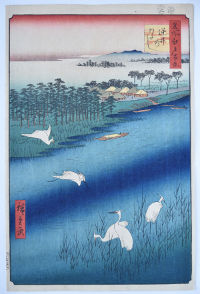
Click here to view image full size.
Sakasai no watashi, “Ferry at Sakasai” from Meisho Edo hyakkei, the “One Hundred Famous Views of Edo.” The set published by Uoya Eikichi between 1856 and 1858, this being 1857. The set shows famous sights, popular annual events, and festivals in and around Edo in the four seasons. Two Chinese egrets are seen flying down to join other egrets on the Nakagawa. The ferry is seen in the background.
Very fine impression of the first edition. Fine colour and condition. Signed Hiroshige ga.
Status: Sold
Utagawa HIROSHIGE (1797-1858)
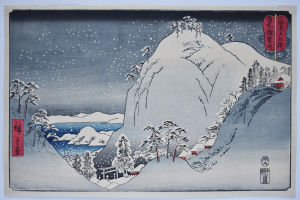
Click here to view image full size.
A snow scene Bizen Yugayama, “Mount Yuga in Bizen [Province].” From a set of 20 prints Sankai mitate sumo, “Mounains and Sea Contending Like Wrestlers.” The title is in a sumo umpire’s fan (a gunbai). There are 10 prints of mountains and 10 prints of harbours. The set was published by Yamadaya in 1858 (except for Etchu Tateyama which was published by Marujin). A beautiful print.
Fine impression, colour and condition. There is an anomaly here (as sometimes happens in Ukiyo-e): The first edition of this set has a variegated cartouche. However, the impression here is unquestionably the earliest but has only a one-colour cartouche. Signed Hiroshige ga.
Status: Sold
Utagawa HIROSHIGE (1797-1858)
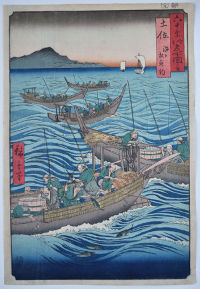
Click here to view image full size.
Tosa, kaijo katsuo tsuri, “Tosa [Province], Bonito Fishing at Sea.” From a set of 69 prints [Dai Nihon] Rokujuyoshu meisho zue, “Famous Places in the Sixty-odd Provinces [of Japan]” published by Koshihei between 1853 and 1856, this being 1855. Tosa, located on the southern coast of the island of Shikoku, was famous for its bonito.
Very fine impression of the first edition. Fine colour and condition. Signed Hiroshige ga.
Status: Sold
Utagawa HIROSHIGE (1797-1858)
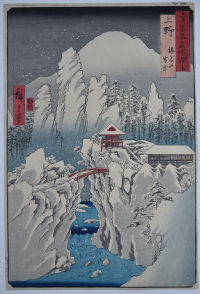
Click here to view image full size.
Kozuke, Harunasan setchu, “Kozuke [Province], Mount Haruna Under Snow.” From a set of 69 prints [Dai Nihon] Rokujuyoshu meisho zue, “Famous Places in the Sixty-odd Provinces [of Japan]” published by Koshihei between 1853 and 1856, this being 1853. A red bridge spans a gorge with precipitous cliffs and a fast flowing river. Fantastic crags point upwards into the sky. In the distance is Mount Haruna – a sleeping volcano.
Very good impression. Good colour. Trimmed close, otherwise good condtion. Signed Hiroshige ga.
Status: Sold
Utagawa HIROSHIGE (1797-1858)
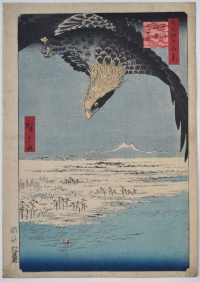
Click here to view image full size.
Fukagawa, Suzaki, Juman-tsubo, “One Hundred Thousand Tsubo Plain, Suzaki, Fukagawa” from Mesho Edo hyakkei, “Hundred Famous Views of Edo.” The set published by Uoya Eikichi between 1856 and 1859 (this being 1857). An eagle hovers over the snowy coastal plain, Mt. Tsukuba and the Chiba mountains in the distance. Collectors at the beginning of the 20th century considered this the pre-eminent design from the set. Since then Ohashi has replaced it.
Very good impression and colour. Slight edge soil, otherwise very good condition. Signed Hiroshige ga.
Status: Sold
Utagawa HIROSHIGE (1797-1858)
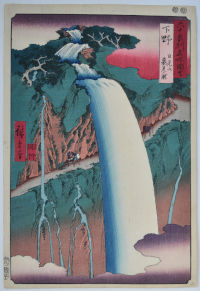
Click here to view image full size.
Shimotsuke Nikkosan urami no taki, “Back-viewed Waterfall on Mt. Nikko in Shimotsuke [Province}.” From a set of 69 prints [Dai Nihon] Rokujuyoshi meisho zue, “Famous Places in the Sixty-odd Provinces [of Japan]” published by Koshihei between 1853 and 1856, this being 1853. Figures gaze up at the back of the waterfall which thunders over the path. It is also known with variant colour schemes. A fine design.
Very fine impression with strong blind-printing on the fall. Very fine colour. Light album backing, otherwise fine condition. Signed Hiroshige ga.
Status: Sold
Utagawa HIROSHIGE (1797-1858)
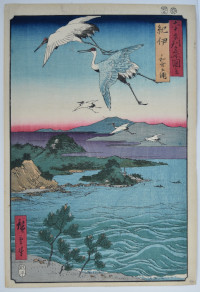
Click here to view image full size.
Kii Wakanoura, “Waka Bay in Kii [Province}.” From a set of 69 prints [Dai Nihon] Rokujuyoshi meisho zue, “Famous Places in the Sixty-odd Provinces [of Japan]” published by Koshihei between 1853 and 1856, this being 1855. Shows cranes taking off from the bay.
Very fine impression and colour. Light album backing, otherwise fine condition. Signed Hiroshige ga.
Status: Sold
Utagawa HIROSHIGE (1797-1858)
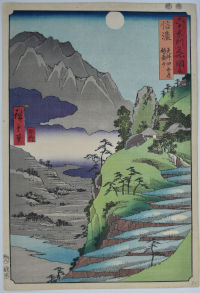
Click here to view image full size.
Shinano, Sarashina tagoto no tsuki Kyodaisan, “The Moon Reflected in the Sarashina Paddy-fields, Mt. Kyodai, Shinano [Province}.” From a set of 69 prints [Dai Nihon] Rokujuyoshi meisho zue, “Famous Places in the Sixty-odd Provinces [of Japan]” published by Koshihei between 1853 and 1856, this being 1853. It was a popular outing to view the multiple images of the moon reflected in the pools.
Very fine impression and colour. Light album backing, otherwise fine condition. Signed Hiroshige ga.
Status: Sold
Utagawa HIROSHIGE (1797-1858)
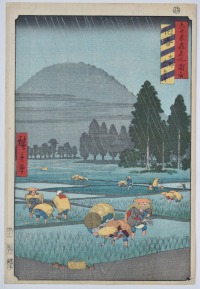
Click here to view image full size.
Hoki, ono Daisen enbo, “Hoki [Province], Distant View of Mount Daisen.” Shows rice-planting in the rain, with the volcanic mountain in the background. From a set of 69 prints [Dai Nihon] Rokujuyoshi meisho zue, “Famous Places in the Sixty-odd Provinces [of Japan]” published by Koshimuraya Heisuke between 1853 and 1856, this being 1853.
Very fine impression and colour. The rain printed with gofun. Light album backing, otherwise fine condition. Signed Hiroshige ga.
Status: Sold
Utagawa HIROSHIGE (1797-1858)
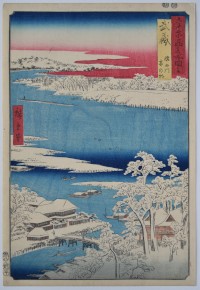
Click here to view image full size.
Musashi, Sumidagawa, yuki no ashita, “Musashi [Province], Sumida River, Morning after Snow.” From a set of 69 prints [Dai Nihon] Rokujuyoshi meisho zue, “Famous Places in the Sixty-odd Provinces [of Japan]” published by b Koshimuraya Heisuke between 1853 and 1856, this being 1853.
Very fine impression and colour. Light album backing, otherwise fine condition. Signed Hiroshige ga.
Status: Sold
Utagawa HIROSHIGE (1797-1858)
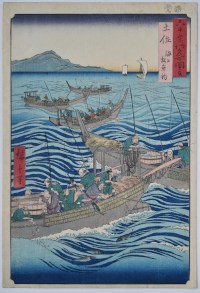
Click here to view image full size.
Tosa, kaijo katsuo tsuri, “Tosa [Province], Bonito Fishing at Sea.” Fishermen used fishing rods, rather than nets, to reduce the stress on the fish and maximise taste. Tosa, located on the southern coast of the island of Shikoku, was famous for its bonito. From a set of 69 prints [Dai Nihon] Rokujuyoshi meisho zue, “Famous Places in the Sixty-odd Provinces [of Japan]” published by b Koshimuraya Heisuke between 1853 and 1856, this being 1855.
Very fine impression and colour. Light album backing, otherwise fine condition. Signed Hiroshige ga.
Status: Sold
Utagawa HIROSHIGE (1797-1858)
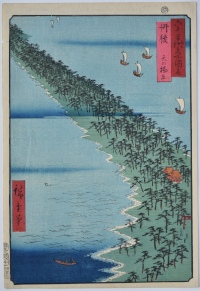
Click here to view image full size.
Tango Province, Amanohashidate (“Bridge to Heaven”). One of Japan’s three scenic views. The sandbar, located in Miyazu Bay, is said to resemble a pathway connecting heaven and earth. Also known for its fine pine trees. From a set of 69 prints [Dai Nihon] Rokujuyoshi meisho zue, “Famous Places in the Sixty-odd Provinces [of Japan]” published by b Koshimuraya Heisuke between 1853 and 1856, this being 1853.
Very fine impression and colour. Light album backing, otherwise fine condition. Signed Hiroshige ga.
Status: Sold
Utagawa HIROSHIGE (1797-1858)
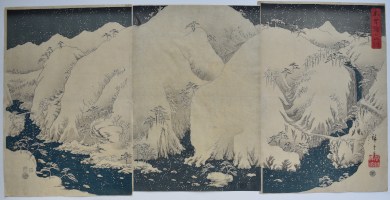
Click here to view image full size.
Kisoji no Yamagawa, “Mountain River on the Kiso Road.” One of Hiroshige’s most iconic images: Snow from an untitled set of three Setsugekka (“Snow, Moon, Flowers”) triptychs. The other two being Moon at Kanazawa and Whirlpools at Awa. The Setsugekka theme was taken from a poem by Tang dynasty poet Bai Juyi (Haku Rakuten). It’s a metonym for beautiful views, etc. This part of the Kiso Road was particularly treacherous but it’s not possible to identify the exact location and Hiroshige most likely used a certain amount of artist’s license. Published by Okasawaya Taheiji, 1857, a year before his death.
Fine impression and colour. Centre sheet lightly backed and slightly trimmed, otherwise very good condition. Signed Hiroshige hitsu with Bokurin Shokoku seal.
Status: Sold
Utagawa HIROSHIGE (1797-1858)
Click here to view image full size.
Mochizuki from Kisokaido rokujukyutsugi no uchi, “The Sixty-nine Stations of the Kisokaido.” The set of seventy prints was started by Eisen and published by Hoeido in 1835, but in 1837 Hiroshige took over and completed the series with the publisher Iseya Rihei (Kinjudo). Shows travellers on the Uryu Slope between Yawara and Mochizuki. Mount Tateshima to the right. One of the finest designs from the set.
Fine early impression with gradation over the moon and woodgrain showing. Fine colour. Very slight centrefold and soil in left margin, otherwise very good condition. Signed Hiroshige ga.
Status: Sold
